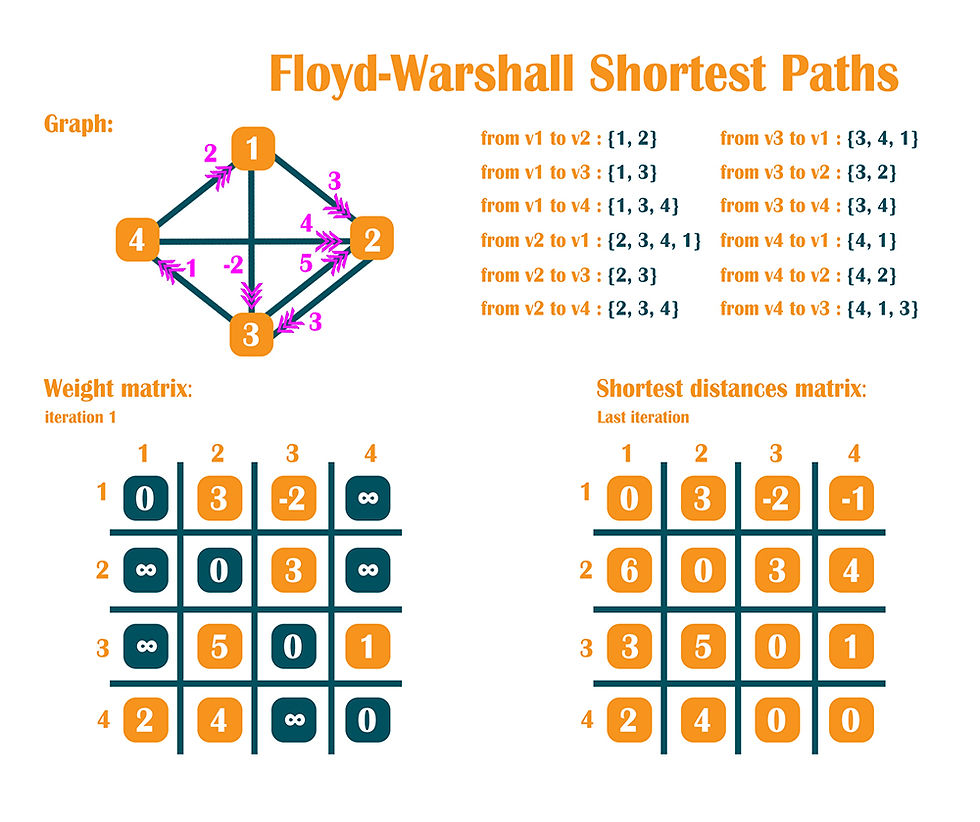Floyd Warshall Algorithm in C++
- oanaunciuleanu

- 20 mai 2020
- 2 min de citit

This algorithm is used to find the shortest path between all pairs of vertices, including negative edges.
// Floyd-Warshall Shortest Paths Algorithm
#include <iostream>
#include <climits>
#include <iomanip>
using namespace std;
#define Vertices 4
// Print path from vertex
void printPath(int pathMatrix[][Vertices], int i, int j)
{
if (pathMatrix[i][j] == i)
{
return;
}
printPath(pathMatrix, i, pathMatrix[i][j]);
cout << pathMatrix[i][j] + 1 << " ";
}
void printSolution(int costMatrix[Vertices][Vertices], int pathMatrix[Vertices][Vertices])
{
// print matrix of shortest paths
cout << "Shortest Paths Values Matrix: " << endl;
for (int i = 0; i < Vertices; i++)
{
for (int j = 0; j < Vertices; j++)
{
if (costMatrix[i][j] == INT_MAX)
{
cout << setw(4) << "inf";
}
else
{
cout << setw(4) << costMatrix[i][j];
}
}
cout << endl;
}
// print info for each vertex
cout << endl;
cout << "Shortest Paths: " << endl;
for (int i = 0; i < Vertices; i++)
{
for (int j = 0; j < Vertices; j++)
{
if (j != i && pathMatrix[i][j] != -1)
{
cout << "From vertex " << i + 1 << " to vertex " << j + 1 << ": " << i + 1 << " ";
printPath(pathMatrix, i, j);
cout << j + 1 << endl;
}
}
}
}
void FloydWarshall(int matrix[][Vertices])
{
int costMatrix[Vertices][Vertices];
int pathMatrix[Vertices][Vertices];
// initialize the 2 matrices
for (int i = 0; i < Vertices; i++)
{
for (int j = 0; j < Vertices; j++)
{
// the initial cost is the original weight of the matrix
costMatrix[i][j] = matrix[i][j];
if (i == j)
{
pathMatrix[i][j] = 0;
}
else if (costMatrix[i][j] != INT_MAX)
{
pathMatrix[i][j] = i;
}
else
{
pathMatrix[i][j] = -1;
}
}
}
// Floyd-Warshall
for (int i = 0; i < Vertices; i++)
{
for (int j = 0; j < Vertices; j++)
{
for (int k = 0; k < Vertices; k++)
{
if (costMatrix[j][i] != INT_MAX && costMatrix[i][k] != INT_MAX && costMatrix[j][i] + costMatrix[i][k] < costMatrix[j][k])
{
costMatrix[j][k] = costMatrix[j][i] + costMatrix[i][k];
pathMatrix[j][k] = pathMatrix[i][k];
}
}
if (costMatrix[j][j] < 0)
{
cout << "Negative Weight Cycle Found!";
return;
}
}
}
printSolution(costMatrix, pathMatrix);
}
int main()
{
int matrix[Vertices][Vertices] =
{
{ 0, 3, -2, INT_MAX },
{ INT_MAX, 0, 3, INT_MAX },
{ INT_MAX, 5, 0, 1 },
{ 2, 4, INT_MAX, 0 }
};
FloydWarshall(matrix);
}Shortest Paths Values Matrix: 0 3 -2 -1 6 0 3 4 3 5 0 1 2 4 0 0Shortest Paths:From vertex 1 to vertex 2: 1 2From vertex 1 to vertex 3: 1 3From vertex 1 to vertex 4: 1 3 4From vertex 2 to vertex 1: 2 3 4 1From vertex 2 to vertex 3: 2 3From vertex 2 to vertex 4: 2 3 4From vertex 3 to vertex 1: 3 4 1From vertex 3 to vertex 2: 3 2From vertex 3 to vertex 4: 3 4From vertex 4 to vertex 1: 4 1From vertex 4 to vertex 2: 4 2From vertex 4 to vertex 3: 4 1 3
Comentarii